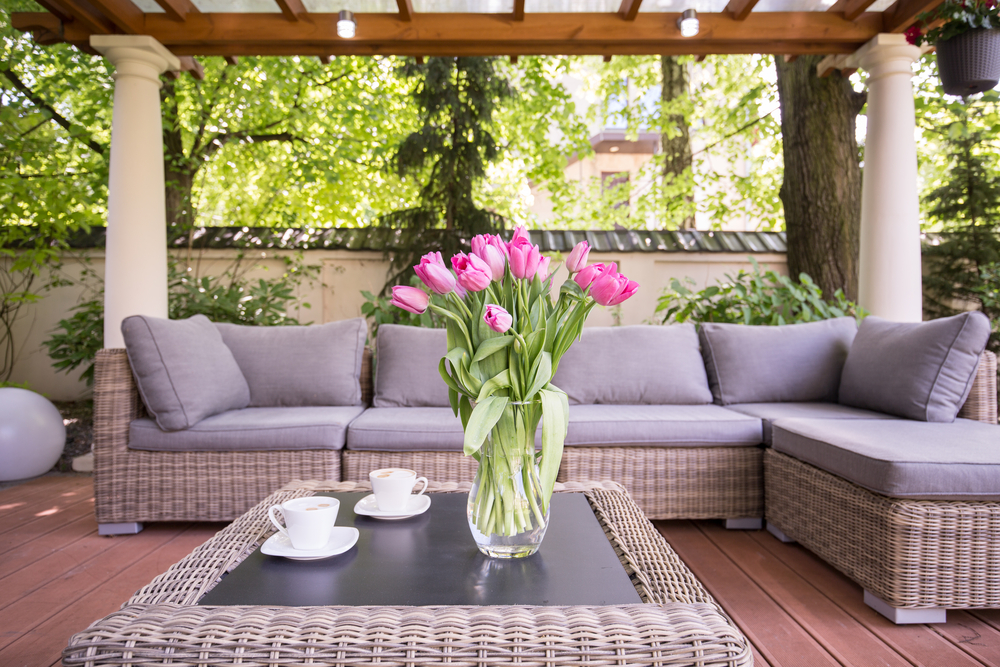Choosing the Right Outdoor Couch for Your Family

Everyone has a barbecue. Everyone has some chairs they can move outside for a few hours. Most people even have a cooler somewhere that they can fill with ice and beverages. All these things are good; they make it possible to relax somewhat comfortably in the backyard. But there’s nothing in the world that takes a backyard or patio environment from merely usable to positively inviting like an outdoor couch.
These days, it’s even easy to find an outdoor couch that’s made of a material which renders it virtually maintenance free. Of course, the other materials and their care needs–wood, wrought iron and the like–are still available. The great thing about shopping for an outdoor couch today is that there’s a whole spectrum of maintenance needs and you can cherry-pick where you want your couch to be on that spectrum.
Besides the frame material, another important point is cushion filling, cushion covers, and the removability of cushions. There is little advantage to cushions being sewn into an outdoor couch. Conversely, removable ones can be cleaned and maintained easily. Their covers can also be washed and changed, ensuring maximum protection and appearance flexibility.
Little Care
Aluminum is heavy on pros and light on cons; thus, it’s naturally the easiest frame material to find. Most aluminum outdoor couches are light enough to be moved easily. With that luxury, you can both rearrange the patio and move furniture to shelter when inclement weather strikes.
But frankly, aluminum resists rust and sometimes has a special powder coating over the finish for added protection. If you’re concerned about your cushions, you can easily bring those inside and simply leave the frame outside to do its aluminum thing–that is, get wet and then get dry, sans damage. Just be ready to take a spray bottle and rag out there before you put the cushions back on. Precipitation brings dust and a simple spritz of water followed by a wipe is plenty to get an aluminum outdoor couch looking like new again.
Resin wicker is another uber-common way that outdoor couches come. The term “wicker”, turns out, just refers to the weaving style. Traditional wicker was done with rattan and cane, but most wicker outdoor couches today have a synthetic material wrapped around an aluminum frame.
Wicker is nearly as easy to care for as aluminum, with two main potential soft spots to mind. Clearly, there are many more surfaces on a wicker couch than a plain aluminum one. All these surfaces woven together can act as a sort of net, catching dust. But this can be remedied in the same way as with aluminum: a spray bottle with just water and a towel. The other thing to look for with a wicker outdoor couch is that some of them can be damaged by too much heat and sunlight. Look closely at the specifications of the piece you’re considering if this is important to you.
Medium Care
There’s just something about wood that will always be attractive. It’s the most basic material to make any furniture from and it evokes a natural sort of calm feeling.
But wood does require more care than aluminum. The first thing to do, just like with your fence and deck, is to find out if the wood has been sealed against moisture; if not, you’ll need to apply your own sealant. If the wood stays untreated altogether, you’ll always have to be moving it in and out of shelter. Wood is heavier, too–that’s a more formidable job with these outdoor couches.
Steel and wrought iron need about the same level of care as wood. Both are often–but not always–treated with water sealants like wood is, which goes a long way toward warding off rust. Again, read the specs and find out for sure if you’ll have to apply your own water sealant to any outdoor couch made from steel or wrought iron. You’ll also want to keep an eye out for any chips in the frame; treat these with the same sealant immediately.
Cushions
It’s also important to make sure the piece you decide on has cushions filled with an appropriate material. Thankfully, this is also fairly easy to do. Most outdoor cushions are filled with a polyfiber material which doesn’t absorb and resists mildew. If the cushions themselves do get wet, stand them on edge to dry. After just a half hour, any polyfiber-filled cushion should show dramatic improvement.
Now, we choose cushion filler that naturally doesn’t absorb water and resists mildew because things happen and cushions get wet–but ideally, we want to prevent our cushions from getting wet in the first place, as much as possible. That’s why we invest in hearty, mildew-resistant cushion covers. The ones at Fig Leaf are machine-washable so after they’ve done their job of protecting your cushions from whatever craziness can happen out there, they can be restored to like-new as easily as a pair of jeans can.
How to Pick the Right Outdoor Couch for Your Family
Make it beautiful! Find your favorite-looking outdoor couch and see if it’s made of the material(s) that you’ve decided you want. If not, it’s a wide world out there–find your other favorite!
Aluminum or wicker will be the easiest to take care of and to move. Wood, steel, and wrought iron provide specific aesthetics which can be wonderful but do require a bit more maintenance. When you’re choosing, consider how often you imagine using your outdoor couch and how much time you’ll be willing to spend cleaning it.
Once you’ve decided on what material your outdoor couch’s frame should be made of, you can take a quick look at the cushion filler. Most product descriptions online provide this detail; if you’re at a store, ask the salesperson. This is an important question and it’s usually easy to find the answer.
Finally, whatever materials you decide on, make sure to get some beautiful outdoor cushion covers. You can customize the look of your outdoor couch and protect the cushions. With proper care, maybe you’ll never need to buy another outdoor couch again!

